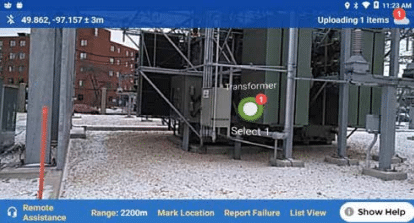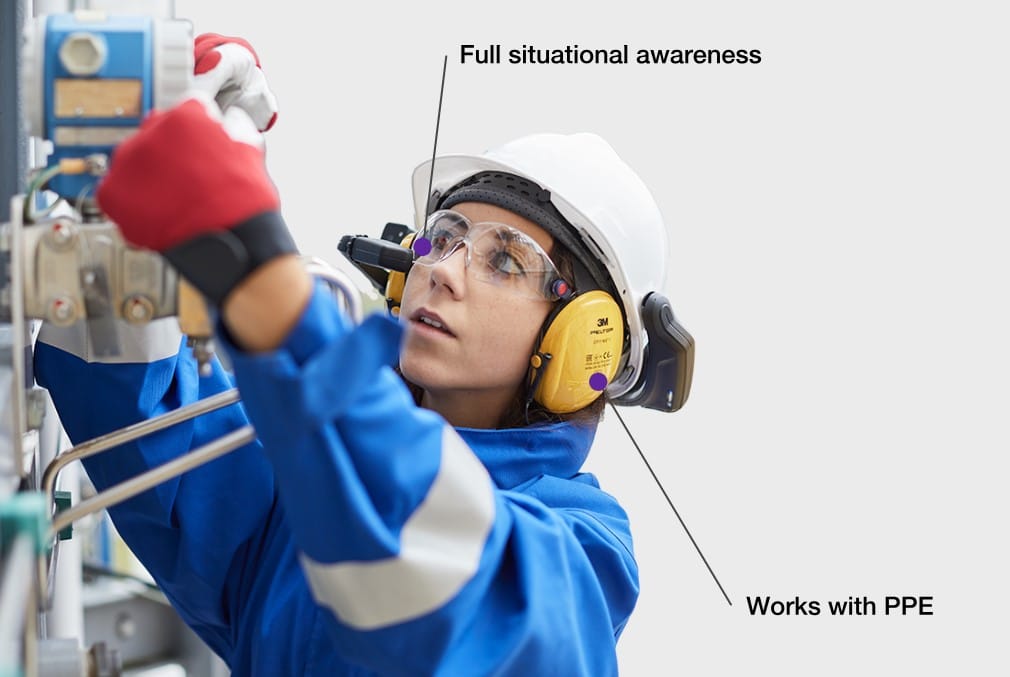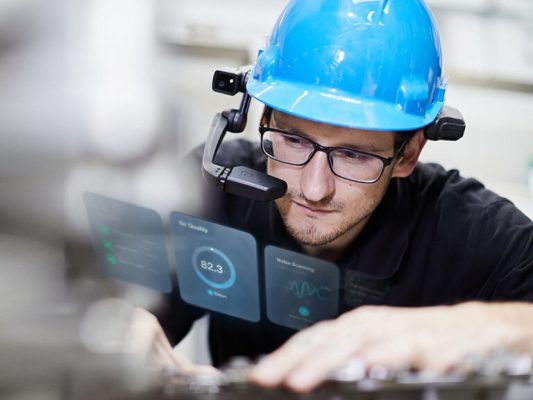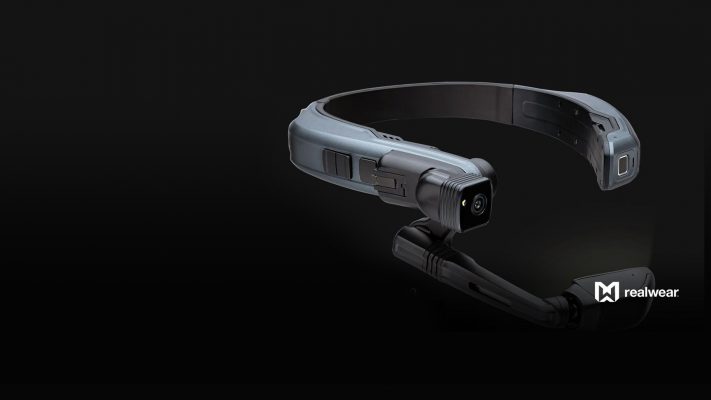Industrial augmented reality (IAR) is ranked by the European Union as one of the main technologies that will drive the development of the smart factory.*
A true “game changer” for industries, augmented reality enhances remote operations, visualization and training. Let’s look at some examples.
Sommario
- 1 A “silent” revolution in the world of industry
- 2 The potential of smart industry in automation
- 3 Smart industry: research, statistics and case studies
- 4 AR and AR protagonists of the fourth industrial revolution
- 5 Simplification of AR processes
- 6 Five ways to optimize processes with AR
- 7 Three types of AR technologies used in production:
- 8 Automated production lines
- 9 The RealWear Visor as a Key Tool
- 10 The Hirschmann Automotive Example
- 11 The Burns & McDonnell Case
- 12 RealWear, the award for the Best Manufacturing and Industrial Solution.
- 13 REQUEST A NO-OBLIGATION DEMO
- 14 About Fastbrain and why to choose it
A “silent” revolution in the world of industry
Assisted reality (AR) and augmented reality (AR) are revolutionizing the industry, seemingly quietly.
Despite not attracting the media attention and involvement of artificial intelligence, extended reality technologies are already changing industrial assets.
From an Anitec-Assinform report, in 2020 alone, companies in Italy spent 700 million euros on wearable technologies including AR visors, an 8.9 percent increase over 2019, with a global AR user base of nearly 600 million.
According to the report Industrial IoT*: A reality Check by Reply the market for smart industry is expected to arrive in Italy alone at 1.547 million by 2025, with a value in the Europe-5 cluster (which includes the top 5 economies in the EU) of more than 23 billion euros, actually registering a threefold growth since 2020.
Among the benefits of this increasingly needed technology are the remote testing, from which companies such as Ansaldo and General Elecryic* benefit, the drastic reduction of lead times (75 percent) and travel expenses that affect up to 6 percent of the final cost of installations at a significantly lower environmental impact, reducing tons of CO2 for intercontinental and trans-European travel.
The potential of smart industry in automation
The opportunities that intelligent assisted reality offers industries today are unprecedented.
Even in the fields of industrial lathes, numerical control (CNC) machines, automated production lines, and beyond, remote testing and training become indispensable to save time and economic resources by providing qualified assistance and constant professional monitoring.
Specifically,
the integration of the RealWear visor
into these applications provides an advanced solution for servicing customers around the world, enabling technicians to remotely guide end users through real-time collaboration.
In industrial lathes and CNC machines, RA and AR play a crucial role in optimizing operations and remote assistance.
The use of the RealWear visor, with its hands-free interface and the ability to display diagrams, instructions and guides directly in the operator’s field of view, offers a significant advantage.
Technicians can:
- Send detailed instructions and troubleshooting procedures directly to the client’s viewer;
- Reduce downtime;
- Improving efficiency.
<strong>Request a free demo</strong>
Smart industry: research, statistics and case studies
The study “Adopting augmented reality in the age of industrial digitization“* points out that “industrial augmented reality (IAR) is one of the key pillars of industrial digitization concepts, connecting workers with the physical world through the overlay of digital information.”
For example, in the CNC industry, where accuracy is critical, RA allows crucial information on machine status or machining parameters to be superimposed directly on the work surface.
This allows operators to have immediate access to critical data without having to interrupt the workflow.
The use of the RealWear visor, with its rugged design resistant to industrial conditions, is perfectly suited to these settings, providing instant assistance without compromising safety.
Below are some case studies and practical applications.
AR and AR protagonists of the fourth industrial revolution
The fourth industrial revolution is already underway, with a valuation of $131 billion in 2022, set to reach $377 billion by 2030 in the Industry 4.0 market.
This rapid growth partly reflects the urgency of companies to implement digital tools such as AR in production processes.
Augmented reality (AR) is rapidly being integrated into manufacturing processes by companies seeking the benefits of industrial digitization.
With uses ranging from prototyping to assembly, this technology simplifies a number of tasks.
The benefits of industrial digitization are many and far-reaching, as demonstrated by the impact of augmented reality cars on the automotive industry.
Simplification of AR processes
Among the various technologies in this quiet revolution, AR in manufacturing is of particular importance, given its ability to streamline a range of processes, from training to quality assurance.
It is safe to say that the manufacturing sector is already taking full advantage of this.
Using the AR:
- A technician can immediately recover the health status of a piece of machinery;
- His repair historian;
- The repair manual and safety warnings;
- All from a single device, saving money, time and effort.
Statistics from Grandview Research* testify to this, with the value of the AR and VR market in manufacturing estimated at $5.6 billion in 2021, rising to $8.0 billion in 2022, with the forecast to reach $62.7 billion by 2030.
The report attributes this growth to the increased use of industrial robots in manufacturing, which in turn fuels demand for AR.
Five ways to optimize processes with AR
Here are five ways manufacturers are using AR to streamline their processes and increase efficiency:
- Training and skills upgrading: AR enables companies to provide workers with an immersive learning experience, reducing the time and effort required.
- Digital work instructions: AR reduces errors by overlaying instructions directly on the work surface, simplifying the documentation of instructions.
- Prototyping: AR simplifies prototyping by enabling designers to visualize working prototypes in the real world, reducing the costs associated with physical prototyping.
- Quality control: AR allows workers to project 3D visualizations of prototypes onto any workspace, facilitating rapid quality checks during production.
- Continuous maintenance: AR reduces time for routine repairs by simplifying access to necessary information.
In various industries, the adoption of augmented reality is already widespread, such as in automotive, aerospace and defense, electronics and medical sciences.
Three types of AR technologies used in production:
- AR on tablets: Interaction with digital objects via a tablet or mobile phone through a designated AR app, useful for monitoring simple tasks.
- Wearable AR: Interaction with digital objects through headset or glasses, reducing the time spent switching between working and consulting a manual.
- Projected AR: Interactive display of AR objects on any surface, useful for processes such as testing, training, inspection and maintenance.
Automated production lines
In automated production lines, RA can improve preventive maintenance by enabling technicians to monitor the status of equipment in real time through the RealWear viewer.
Data on machine performance, any impending faults or production processes can be displayed directly in the operator’s field of view.
This proactive approach to maintenance reduces downtime and optimizes overall operational efficiency.
The most revolutionary aspect of AR and the use of the RealWear visor is the remote support for customers around the world.
A customer wearing the visor can connect with technicians from the machinery company to receive instant assistance.
Technicians can see exactly what the customer sees, providing detailed instructions, marking crucial elements in the field of view, and guiding the user through complex procedures.
This reduces the need to physically send a technician to the site, saving time and resources.
In addition, AR and the use of the RealWear visor are particularly useful in global scenarios, where geographic distance can be an obstacle.
The company can offer immediate, high-quality support to customers anywhere in the world, improving customer satisfaction and creating a competitive advantage.
The RealWear Visor as a Key Tool
In the context of machinery companies, the RealWear visor stands out as a key tool in the enjoyment of Intelligent Assisted Reality (ARI).
With its robust and durable design, it is ideal for industrial environments.
Technicians can wear the visor hands-free, allowing them to access crucial information while keeping their hands free for hands-on operation.
The integration of the RealWear viewer into the RAI provides a quantum leap in customer service, training, and operations optimization. Machinery companies are embracing this technology as an essential element to remain competitive and lead the industry into an innovative future.
From design to production, maintenance to customer service, RAI is revolutionizing the entire life cycle of industrial products, leading to greater operational efficiency and unprecedented technological advancement.
<strong>Request a demo and discover the potential of the RealWear visor for your company</strong>
The Hirschmann Automotive Example
Hirschmann Automotive, an international automotive supplier founded in 1959, has successfully implemented an intelligent assisted reality-based solution to improve internal collaboration and reduce equipment downtime.
Using RealWear with Cisco Webex Expert on Demand, the company was able to achieve the following results:
- Reduced travel needs and costs.
- Improved response to maintenance and repair activities.
- Simplified access and collaboration to information.
- Increased resolution rates at first intervention.
- Reduced time required for resolution at first intervention.
The case study* highlights how Hirschmann Automotive, with seven plants in 10 countries and more than 5,500 employees, has improved efficiency in internal communication through the implementation of Cisco Webex, enabling more effective collaboration between global departments.
Initially, the problem was the lack of internal collaboration capabilities in the company’s communication infrastructure. RealWear HMT-1 was introduced as a solution, providing a rugged Android device in the form of a viewer, integrated with Cisco Webex Expert on Demand.
This allowed technicians to view information hands-free during equipment maintenance.
The case study highlights the success of Hirschmann Automotive’s digital transformation of production plants, especially during the COVID-19 pandemic, when the RealWear HMT-1 enabled technicians to collaborate with experts by working remotely.
This has resulted in increased first-intervention resolution rates and a significant reduction in travel expenses.
Klemens Fliri, Collaboration Services Manager, points out that the implementation not only maintained operations during the pandemic but also helped improve overall efficiency, saving time, money and reducing frustration associated with international travel.
Fliri sees the potential to offer customers real-time support and the ability to remotely view production processes, positioning the company in a competitively advantageous position.
The Burns & McDonnell Case
Burns & McDonnell, an engineering, consulting, and construction firm with more than 7,000 professionals, has successfully implemented reality-assisted technology with RealWear and VisualSpection to streamline site documentation and enable Burns & McDonnell senior experts to virtually inspect sites without having to physically travel.
Achievements include a 33 percent reduction in field errors, the ability for experienced employees to monitor multiple sites simultaneously, and up to five times faster completion of distribution asset documentation.
In the utilities sector, Burns & McDonnell faced the challenge of improving site assessment, traditionally based on manual collection of asset information.
The company then implemented a pilot program to test assisted and augmented reality technology in the field, eventually choosing RealWear HMT-1 visors with Manitoba Hydro International’s VisualSpection application.
Key advantages of RealWear visors include their adaptability for use in the field, impact resistance, long battery life and the ability to wear them on safety helmets.

In addition, the device offers familiarity as a wearable Android tablet, hands-free operation, ease of use with voice commands, and collaboration capabilities through real-time videocalls with remote experts.
The RealWear-VisualSpection solution enabled field workers to collect large amounts of data from sites and deliver it to end users in easily understood formats.
Assisted reality technology has improved the efficiency of field workers by enabling virtual site review and remote collaboration during travel restrictions and social distancing rules during the pandemic.
Wearable Tech from Burns & McDonnell
Burns & McDonnell predicts that at least 50 percent of the industry will adopt this assisted reality technology, which is particularly beneficial for professionals in the field, offering the ability to maintain project progress in situations of limited access or during crises such as that caused by the pandemic.
RealWear, the award for the Best Manufacturing and Industrial Solution.
RealWear won the award for “Best Manufacturing and Industrial Solution” at the XR Awards 2023, celebrated on June 14 of the same year. This win comes on top of the previous year’s accolades, when RealWear was awarded “Best Industrial Solution,” “Best Construction Solution,” and “Best Automotive Solution.”
The selection of winners is based on innovation, impact in their industry, and other relevant factors, including benefits provided to customers. With over 400 participants, only 16 applications were awarded.
XR Today engaged a group of industry experts as judges, each bringing a wealth of knowledge and diversity.
Jon Arnold, vice president of EMEA at RealWear, said the win as “Best Manufacturing and Industrial Solution” is a recognition of RealWear’s customer-centric strategy and ongoing commitment to offering innovative assisted reality solutions for the manufacturing and industrial sectors.
RealWear visors are considered the gold standard of head-mounted wearable devices for frontline professionals.
The flagship models, RealWear Navigator® 500 and 520, enable professionals to access real-time schematics and drawings, run guided workflows, and use artificial intelligence and computer vision to identify defects in parts in real time.
With this latest award from XR Today, RealWear reaffirms its commitment to providing transformative solutions that revolutionize the future of work, providing instant access to information and experts while your hands and field of vision remain free for work.
The company has achieved proven success in the field with top clients such as Shell, Goodyear, Mars, Colgate-Palmolive, and BMW, helping to improve workplace safety and providing an unprecedented return on investment.
About Fastbrain and why to choose it
Fastbrain Engineering Ltd. Certified Partnerof leading Technology Players, including RealWear®, Brother, Lenovo, Synology, Graetz, SiComputer, Canyonoffers customized purchasing solutions tailored to the needs of professionals. It also offers pre- and post-sales support,including operational rental. We are acentralplayer in ICT wholesale distribution and one of the leading players throughout the country in the IT and technology products distribution market. A key feature and competitive advantage is the selection of top brands and leading products in the most popular product categories.
Info:
info@fastbrain.it
| Tel 011.0376.054
Resources:
https://www.sciencedirect.com/science/article/abs/pii/S0166361519301186
https://www.realwear.com/wp-content/uploads/2021/10/RealWear_CaseStudy_Burns-McDonnell_011221A.pdf
https://www.realwear.com/wp-content/uploads/2021/10/RealWear_CaseStudy_HirschmannAutomotive_011721A.pdf
*https://www.reply.com/it/iot
*https://www.wired.it/economia/start-up/2021/10/13/realta-aumentata-fabbrica/
https://www.ienhance.co/insights/how-companies-are-implementing-augmented-reality-in-manufacturing
RealWear Wins Best Manufacturing and Industrial Solution at XR Awards 2023





